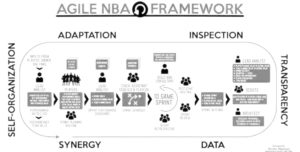A nutshell of Agile NBA ? What is this framework all about ?
The NBA has become a leader in sports analytics.Every team has a data analyst, data scientist or analytics team. With the advent of spatial data, pro networks, and advanced algorithms, teams are using analytics to use key management decisions.But the challenge keeps the teams from unlocking the full potential of the data is translating this complex data sets and analytics so that the players the ones executing the work can easily understand and most important find ways to add values. The team needs a process that bridges there analytic teams to identify ways of measuring value to the players who are responsible for delivering value on the court. With the introduction of Agile NBA Framework, it becomes easy for measuring value, improving player IQ, and creating synergy among the team. Agile NBA is a framework developed by Victor Holman that every team in the NBA can apply to the existing analytic and reporting systems that translate their data to the results on the court. The rules of Agile NBA binds together the pillars, key roles, events and artifacts governing the relations and interactions between them.
Here is a quick breakdown of how it works :
Agile NBA is built on the foundation of 6 pillars. All processes are designed to promote continuous improvement, team work, and knowledge. There are key roles in Agile NBA. The lead analyst in charge of analytics and reporting performance. The coach and players are responsible for translating these analytics into performance on the court.The assistant coaches responsible for advanced scouting reports, game time statistics and helping players improve skills and create values. The scouts and architects responsible for identifying players outside the organization who fits the team identity and can create value and the agile NBA consultant who ensures that events artifacts and processes are being delivered efficiently. It’s the lead analyst’s job to take inputs from the data sources and key stakeholders to create a prioritized list of key analytics the team must achieve to win games. This list is known as performance matrix log. It contains all identified performance matrix and their assign values. The value represents the impacts they have towards achieving team goals. There are a number of processes and events that go along with Agile NBA and its the Agile NBA consultants duty to ensure that the team applies them properly to achieve team goals. The team performs a series of sprints or 10 game intervals.
Each sprint is preceded by team planning meeting attended by a coaching staff, Players, and lead analyst. Together they select key analytics from performance matrix log that the team will commit how to perform their opponents during the sprint.
The selected items make up the sprint performance dashboard. In addition, the lead analyst provides each player with a custom player value card, which lists the matrix and associated point values based on the player’s role and skill set. It is up to the player to determine which matrix he will had doing the sprint to achieve his target value. Think of the player value cards as a menu for players and the combine value points of the matrix they commit of achieving is their plan value. This achieves player buy in, increases basket ball like you and motivates players to contribute in areas that otherwise go unnoticed. Players learn how to create value and synergy. The team plan value and player plan values along with the Win-loss predictions become the sprint goals. For the next 10 games, the players focus on how to perform their opponents in the matrix identified in the sprint performance dashboard. Following each game, there is a post game meeting where each team reviews their performance and analyses what they right during the game? What they plan to do better in the next game? and what obstacles may keep the team from reaching the sprint goal? At the end of the spring, the result of the sprint, the results of the games, Wins and losses, the actual team value and actual player values during the sprint comes the sprint outcomes. The Sprint outcomes also become the input for the lead analysts, scouts, and architects to identify players around the league internationally and on the college level fit the team identity and needs and can add value. It also allows the coaching staff to see where adjustments will be needed in the next Sprint. The sprint ends with two events, the sprint review which is a demonstration of sprint results to stakeholders and the Sprint retrospective which is an examination of what went well, where the team and players fall short and what could be improved. The aim of the retrospective is to ensure that the next sprint is more efficient and effective than the last and the known outcomes from the matrix fit back into the algorithms for the lead analysts to adjust the matrix values. New identified analytics get placed into the performance matrix log and discussed at the next sprint planning meeting. The process is repeated. Most efficient and effective than the previous sprint.Continuous improvement is achieved, Player IQ is increased and the team gets closer to synergy and that’s Agile NBA nutshell.





